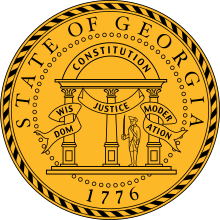Long County, Georgia
Long County is a county located in the U.S. state of Georgia. The county seat is Ludowici.[1] Long County is part of the Hinesville-Fort Stewart Metropolitan Statistical Area. The constitutional amendment to create the county was proposed August 14, 1920, and ratified November 2, 1920. The county is named after Crawford Long (1815–1878), American surgeon and pharmacist, first to use diethyl ether as an anaesthetic.[2]
Long County | |
|---|---|
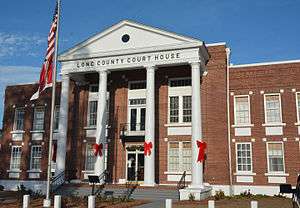 Long County Courthouse in Ludowici | |
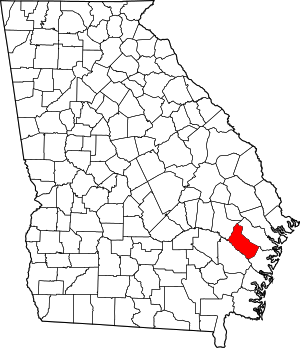 Location within the U.S. state of Georgia | |
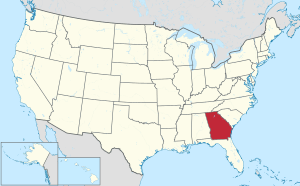 Georgia's location within the U.S. | |
| Coordinates: 31°46′N 81°45′W | |
| Country | |
| State | |
| Founded | November 2, 1920 |
| Seat | Ludowici |
| Largest city | Ludowici |
| Area | |
| • Total | 404 sq mi (1,050 km2) |
| • Land | 400 sq mi (1,000 km2) |
| • Water | 3.5 sq mi (9 km2) 0.9%% |
| Population | |
| • Estimate (2018) | 18,998 |
| • Density | 36/sq mi (14/km2) |
| Time zone | UTC−5 (Eastern) |
| • Summer (DST) | UTC−4 (EDT) |
| Congressional district | 1st |
| Website | www |
As of the 2010 census, the population was 14,464.[3] With a per-capita income of $22,599, Long County is #10 on the list of lowest-income counties in the United States.
| Historical population | |||
|---|---|---|---|
| Census | Pop. | %± | |
| 1930 | 4,180 | — | |
| 1940 | 4,086 | −2.2% | |
| 1950 | 3,598 | −11.9% | |
| 1960 | 3,874 | 7.7% | |
| 1970 | 3,746 | −3.3% | |
| 1980 | 4,524 | 20.8% | |
| 1990 | 6,202 | 37.1% | |
| 2000 | 10,304 | 66.1% | |
| 2010 | 14,464 | 40.4% | |
| Est. 2018 | 18,998 | [4] | 31.3% |
| U.S. Decennial Census[5] 1790-1960[6] 1900-1990[7] 1990-2000[8] 2010-2013[3] | |||
Geography
According to the U.S. Census Bureau, the county has a total area of 404 square miles (1,050 km2), of which 400 square miles (1,000 km2) is land and 3.5 square miles (9.1 km2) (0.9%) is water.[9]
The majority of Long County, roughly centered on Ludowici, is located in the Altamaha River sub-basin of the basin by the same name. The county's northeastern portion, east of Glennville and northwest of Walthourville, is located in the Canoochee River sub-basin of the Ogeechee River basin. Long County's southeastern portion is located in the Ogeechee Coastal sub-basin of the larger Ogeechee basin.[10]
Major highways
Adjacent counties
- Liberty County (northeast)
- McIntosh County (southeast)
- Wayne County (southwest)
- Tattnall County (northwest)
Demographics
2000 census
As of the census[11] of 2000, there were 10,304 people, 3,574 households, and 2,676 families living in the county. The population density was 26 people per square mile (10/km²). There were 4,232 housing units at an average density of 11 per square mile (4/km²). The racial makeup of the county was 68.41% White, 24.25% Black or African American, 0.73% Native American, 0.57% Asian, 0.25% Pacific Islander, 3.91% from other races, and 1.87% from two or more races. 8.44% of the population were Hispanic or Latino of any race.
There were 3,574 households out of which 45.60% had children under the age of 18 living with them, 55.00% were married couples living together, 14.50% had a female householder with no husband present, and 25.10% were non-families. 19.60% of all households were made up of individuals and 5.20% had someone living alone who was 65 years of age or older. The average household size was 2.88 and the average family size was 3.28.
In the county, the population was spread out with 33.10% under the age of 18, 14.20% from 18 to 24, 31.00% from 25 to 44, 15.90% from 45 to 64, and 5.80% who were 65 years of age or older. The median age was 26 years. For every 100 females, there were 102.10 males. For every 100 females age 18 and over, there were 100.70 males.
The median income for a household in the county was $30,640, and the median income for a family was $32,473. Males had a median income of $26,416 versus $18,732 for females. The per capita income for the county was $12,586. About 17.60% of families and 19.50% of the population were below the poverty line, including 26.00% of those under age 18 and 19.80% of those age 65 or over.
2010 census
As of the 2010 United States Census, there were 14,464 people, 5,023 households, and 3,654 families living in the county.[12] The population density was 36.1 inhabitants per square mile (13.9/km2). There were 6,039 housing units at an average density of 15.1 per square mile (5.8/km2).[13] The racial makeup of the county was 62.4% white, 25.2% black or African American, 0.8% Asian, 0.6% American Indian, 0.4% Pacific islander, 7.2% from other races, and 3.4% from two or more races. Those of Hispanic or Latino origin made up 12.3% of the population.[12] In terms of ancestry, 12.1% were German, 10.6% were Irish, 8.3% were American, and 7.1% were English.[14]
Of the 5,023 households, 44.2% had children under the age of 18 living with them, 48.8% were married couples living together, 18.1% had a female householder with no husband present, 27.3% were non-families, and 22.4% of all households were made up of individuals. The average household size was 2.81 and the average family size was 3.28. The median age was 30.6 years.[12]
The median income for a household in the county was $41,186 and the median income for a family was $46,654. Males had a median income of $30,921 versus $25,675 for females. The per capita income for the county was $15,068. About 11.6% of families and 15.8% of the population were below the poverty line, including 20.6% of those under age 18 and 20.0% of those age 65 or over.[15]
Communities
Education
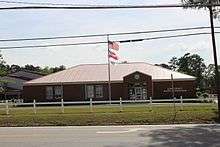
Long County School System operates public schools.
Politics
One of the most anti-Catholic counties in the United States, it was an ancestrally Democratic country that heavily voted against Catholic Democratic candidates (Al Smith in 1928 and John F. Kennedy in 1960). It has become a safe Republican county since 2000.
| Year | Republican | Democratic | Third parties |
|---|---|---|---|
| 2016 | 63.8% 2,626 | 33.0% 1,360 | 3.2% 131 |
| 2012 | 60.5% 2,306 | 37.8% 1,442 | 1.8% 67 |
| 2008 | 61.2% 2,119 | 37.2% 1,288 | 1.5% 53 |
| 2004 | 65.6% 1,994 | 34.0% 1,033 | 0.5% 14 |
| 2000 | 57.0% 1,320 | 42.1% 975 | 0.8% 19 |
| 1996 | 40.1% 791 | 47.5% 936 | 12.4% 245 |
| 1992 | 36.7% 719 | 44.7% 874 | 18.6% 364 |
| 1988 | 55.3% 858 | 43.9% 681 | 0.8% 12 |
| 1984 | 57.4% 1,099 | 42.6% 816 | |
| 1980 | 29.5% 514 | 69.0% 1,202 | 1.6% 27 |
| 1976 | 15.2% 222 | 84.9% 1,243 | |
| 1972 | 76.4% 764 | 23.6% 236 | |
| 1968 | 8.8% 156 | 32.5% 574 | 58.7% 1,037 |
| 1964 | 15.6% 246 | 84.5% 1,336 | |
| 1960 | 76.4% 898 | 23.6% 278 | |
| 1956 | 19.0% 281 | 81.0% 1,195 | |
| 1952 | 37.8% 420 | 62.2% 691 | |
| 1948 | 29.4% 151 | 65.7% 337 | 4.9% 25 |
| 1944 | 28.9% 129 | 71.1% 318 | |
| 1940 | 19.1% 76 | 80.4% 319 | 0.5% 2 |
| 1936 | 14.2% 51 | 85.0% 305 | 0.8% 3 |
| 1932 | 3.1% 14 | 95.8% 430 | 1.1% 5 |
| 1928 | 70.7% 401 | 29.3% 166 | |
| 1924 | 3.4% 19 | 88.5% 499 | 8.2% 46 |
References
- "Find a County". National Association of Counties. Retrieved June 7, 2011.
- Krakow, Kenneth K. (1975). Georgia Place-Names: Their History and Origins (PDF). Macon, GA: Winship Press. p. 135. ISBN 0-915430-00-2.
- "State & County QuickFacts". United States Census Bureau. Archived from the original on June 7, 2011. Retrieved June 23, 2014.
- "Population and Housing Unit Estimates". Retrieved July 31, 2019.
- "U.S. Decennial Census". United States Census Bureau. Retrieved June 23, 2014.
- "Historical Census Browser". University of Virginia Library. Retrieved June 23, 2014.
- "Population of Counties by Decennial Census: 1900 to 1990". United States Census Bureau. Retrieved June 23, 2014.
- "Census 2000 PHC-T-4. Ranking Tables for Counties: 1990 and 2000" (PDF). United States Census Bureau. Retrieved June 23, 2014.
- "US Gazetteer files: 2010, 2000, and 1990". United States Census Bureau. February 12, 2011. Retrieved April 23, 2011.
- "Georgia Soil and Water Conservation Commission Interactive Mapping Experience". Georgia Soil and Water Conservation Commission. Retrieved November 27, 2015.
- "U.S. Census website". United States Census Bureau. Retrieved May 14, 2011.
- "DP-1 Profile of General Population and Housing Characteristics: 2010 Demographic Profile Data". United States Census Bureau. Archived from the original on February 13, 2020. Retrieved December 30, 2015.
- "Population, Housing Units, Area, and Density: 2010 - County". United States Census Bureau. Archived from the original on February 13, 2020. Retrieved December 30, 2015.
- "DP02 SELECTED SOCIAL CHARACTERISTICS IN THE UNITED STATES – 2006-2010 American Community Survey 5-Year Estimates". United States Census Bureau. Archived from the original on February 13, 2020. Retrieved December 30, 2015.
- "DP03 SELECTED ECONOMIC CHARACTERISTICS – 2006-2010 American Community Survey 5-Year Estimates". United States Census Bureau. Archived from the original on February 13, 2020. Retrieved December 30, 2015.
- Leip, David. "Dave Leip's Atlas of U.S. Presidential Elections". uselectionatlas.org. Retrieved March 21, 2018.
